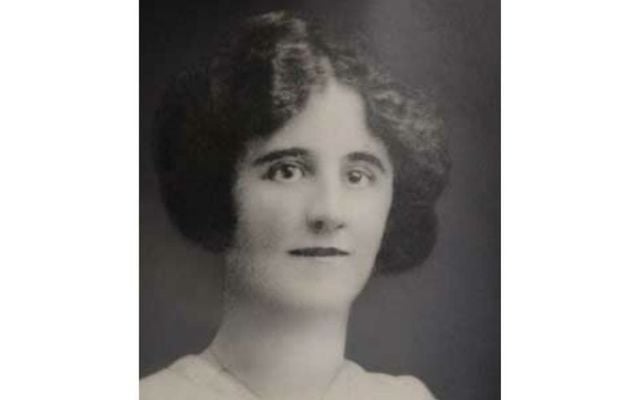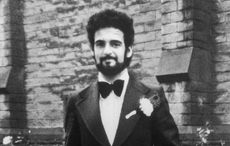On April 15, 1912, Bridget Delia Bradley, from County Cork, went mad with fear and tried to clamber back out of a lifeboat and onto the sinking Titanic.
On April 15, 1912, the Belfast-built RMS Titanic sank after colliding with an iceberg, killing over 1,500 passengers and crew on board. This was one of the deadliest commercial peacetime maritime disasters in modern history and among those on board were many Irish. IrishCentral takes a look at the Irish on board – the lucky, unlucky and heroic.
This is an extract from the book “The Irish Aboard the Titanic” by Senan Molony, which tells the tales of the people who were on board the night the ship went down. This book gives those people a voice. In it are stories of agony, luck, self-sacrifice, dramatic escapes, and heroes left behind.
Bridget Delia Bradley
Ticket number 334914. Paid £7 14s 6d.
Boarded at Queenstown.
Third Class.
From: Ballinahulla, County Kerry; bordering Kingwilliamstown, County Cork.
Destination: 29 William Street, Glen Falls, New York.
She was saved – sitting securely in a lifeboat that was beginning its jolting descent to the water. But Bridget Delia Bradley felt she had to escape from the vessel of her salvation. Demented with fear, she tried to get back on the doomed ship:
"There was a girl from my place, and just when she got down into the lifeboat, she thought that the boat was sinking into the water.
"Her name was Bridget Bradley. She climbed one of the ropes as far as she could and tried to get back into the Titanic again, as she thought she would be safer in it than in the lifeboat. She was just getting up when one of the sailors went out to her and pulled her down again."
-(Daniel Buckley, testifying to the US inquiry, day 12, 3 May 1912)
Buckley also mentioned Bridget in a letter he wrote home from the safety of the rescue ship Carpathia:
"Thank God some of us are amongst the saved. Hannah Riordan, Brigie Bradley, Nonie O’Leary and the Shine girl from Lismore are all right."
-(Letter printed in The Cork Examiner, 13 May 1912)
Bridget’s family believed she was rescued in lifeboat No. 4, launched from the starboard side of the sinking Titanic at 1.55 a.m., but this is inconsistent with her being seen by Daniel Buckley, whose own lifeboat departed a little earlier.
Bridget was interviewed by the Daily Times while still recovering from her ordeal at St Vincent’s Hospital in New York:
"I was in bed at the time the accident occurred and the shock, which was a comparatively slight one, did not disturb me greatly. A knock on the doors of our rooms caused us to get up and dress ourselves. I slipped on a lightweight black dress and wrapped a small shawl about me, the only clothes I saved, and went to the deck where I found the most of the passengers assembled.
"There was no disorder on the deck that amounted to anything, and all the officers acted in a manner that convinced us the ship was not in grave danger. The story that the men on board acted like heroes is true in every detail, and it was ‘women first’ in nearly every case except for a few of the steerage passengers who tried to fight their way to the lifeboats and who I have been told were shot by officers of the boat.
"All the lifeboats were lowered while I was on deck and it looked for a time as if I would be left. I saw men lead their wives to the lifeboats and leave them there, returning to the deck, and we on deck were not so horribly frightened as might be thought. Every one of us thought that it was impossible to sink the ship.
"Just as the last lifeboat, the one with Mr Ismay in it, was launched over the side, one of the officers shouted ‘There’s more room in that boat’ and I and eleven other women were crowded into it. This was after 1 o’clock. I don’t know how much, but it was after one. The lifeboat was manned by enough men to care for it properly and immediately on touching the water, the men rowed with all their strength to get away from the ship, so that, if it did go down, we would not be caught in the suction.
"The night was extremely cold, and we womenfolk had little wraps to keep us warm and we huddled there in clusters watching the great ship as it slowly sank. Not until we got off the boat did we fully realize the danger. Then we saw that the boat had tilted forward and that slowly, but surely, she was sinking.
"We saw the bottom row of lights disappear under the water and watched as line after line disappeared, showing us the rapidity of the sinking of the ship. We were entirely surrounded by large cakes of ice and there was no food or water on the boat, and in the long wait for the Carpathia the majority of us prayed for the coming of the ship. When the welcome ship hove in sight many of us were too much exhausted to realize the greatness of the disaster …
"We were picked up at 6 o’clock and I am informed that every one of the boats that were launched from the Titanic were picked up, with the exception of one which turned over and drowned everyone on board. The relief that we experienced when on board the Carpathia is beyond description, but there was with many a fear that this ship might meet the same fate as the Titanic and it was not until the ship touched the port of New York that we all felt safe.
"To realize what we passed through is impossible for anyone who was not on the ship. The hand of death was over us and as we floated out in the frail lifeboats, with no food or water, and as our thirst began to increase, the thought that we might not be picked up, and huddled up in this manner should die of starvation, made us beside ourselves, and as we prayed the smoke-stack of the Carpathia hove in sight …"
"Practically two out of every three who sailed on the Titanic are now at the bottom of the ocean, and when I realize that I was one of the last twelve to leave the ship, I cannot help thinking what might have been.
"The brave men who went down have left a memory in the hearts of every one of us survivors that will linger as long as we live. The ‘women first’ rule was carried out to the letter and those who had womenfolk on board devoted their time to getting the women in the small boats while they themselves were content to remain on deck.
"A few men, including six Chinese, had hidden under the seats of the lifeboats and were carried out, according to the stories on the Carpathia on Monday night, but it is said that two of them were crushed to death by the weight thrown upon them. There were none of them in our boat."
Bridget was the fifth eldest of nine children who lived in a cottage with no bath or electricity. She occasionally went to school barefoot. Older siblings Mary and Michael emigrated to the United States, both settling in Glen Falls, where Mary became a domestic and her brother a fireman. On discharge from the hospital, a penniless Bridget was assisted by the American Red Cross, receiving $125. She worked as a domestic in Glen Falls for two years before moving to New York and becoming engaged by the wealthy Nicholls family.
She lodged a court claim against the Ocean Steam Navigation Company, owners of the Titanic, in the US District Court, southern district of New York, in company with numerous other litigants. Her claim was for $153 worth of lost personal effects, made up as follows:
"Three pairs high shoes, at $3.50 – $10.50; One lady’s suit, woollen consisting of coat and skirt, $25; Two suits union underwear, flannel $1 – $2; Three pairs woollen stockings, $.50 – $1.50; Three pairs half hose $.50 – $1.50; One lady’s hat with trimmings, $3; One toilet set consisting of brush, comb, soap, tooth brush, one bath towel, two plain towels, one silver soap case, one silver hair pin case and leather case for set – $5; One leather valise – $3.50; Two lady’s dresses, cotton, $3.50 – $7; One black dress, mixed goods, $28; Six white shirt waists, $1 – $6; Cash $25; One large steamer trunk, $10; Paid for medical attendance as result of the collision, $25. Total: $153."
In 1925 Bridget met the supervisor of the Nicholls’ summer estate on Howe Island in the St Lawrence river in Canada. She was 32, he was 40. They were married two days after the following Valentine’s Day at St Patrick’s Cathedral on Fifth Avenue, New York. She was now Mrs Bernard LaSha, and she adopted the first name Delia, a familiar name for Bridget. They settled in Gananoque, Ontario, where their first child, Mary, was born in September 1927. John Joseph arrived fourteen months later, and Rose Henrietta two years after that. Joan Margaret was born in 1931.
By 1929, Delia LaSha, Titanic survivor, had become a boat owner herself. Her husband plowed his savings into a tour boat, named the Sun Dance, to take passengers around the islands of St Lawrence. In the autumn of 1932 he suffered a seizure and on March 29, 1933 died aged 47, at the height of the Great Depression. A few months later, heart worn and suffering from shingles, his widow gave birth to their fifth child, who lived only a few days and was buried with his father.
Bridget could not face the water commerce business herself. She hired a man to operate the Sun Dance, which cut down on her own income, and she took up babysitting to try to make ends meet. In 1951, she suffered a stroke which severely impaired her speech and paralyzed her right arm and leg. The boat was sold.
When the film "Titanic" was shown in the local cinema that same decade, Delia LaSha was guest of honor. Her daughter Mary Higgins recounted: ‘Mom became very emotional during the movie and at times kept shaking her head as if to say it didn’t happen that way. If able to speak, I am sure she would have had many comments to make.’
Three years later she was dead, having outlived her husband by twenty-three years.
According to her death certificate, she was born on January 10, 1893, and passed away on January 24, 1956, aged 63.
* “The Irish Aboard the Titanic” by Senan Molony is available online.
* Originally published in 2013, updated in April 2025.




Comments